
The Iranian Carpet embodies timeless elegance and the rich heritage of Iran’s cultural legacy, standing as a global hallmark of exquisite craftsmanship.
Known worldwide as the Persian Carpet or Iranian Rug, this piece transcends its functional use to become a true work of art. Crafted with unmatched skill, the carpet weaves its own story, encapsulating centuries of tradition and artistry.
The range of designs, from traditional patterns to contemporary styles, ensures that the diversity and superior quality of the Iranian Carpet will meet and exceed your expectations.

Explore the captivating world of the Persian Carpet and elevate your space with Iran’s legendary artistry, a valued treasure among collectors, art lovers, and those who appreciate the intricate beauty of a meticulously woven carpet.
Contents
The History of the Iranian Carpet
The history of Iranian carpet is deeply rooted in ancient times, originally crafted by nomadic tribes as functional art to embellish their tents and shield against the harsh desert climate.
As years passed, this humble craft evolved into an art form celebrated for its intricate design and exceptional workmanship. By the 16th century, these artistic creations had captured European markets, becoming treasured possessions celebrated for their aesthetic appeal and impeccable quality.
The art of carpet weaving in Iran is believed to extend back to as early as 500 B.C. Ancient Persian texts and artifacts offer valuable insights into this mesmerizing craft, revealing a tradition that would eventually captivate global attention.
Pazyryk: The Oldest Iranian Rug
The Pazyryk carpet, discovered in a Scythian tomb located deep within Siberia, stands as a testament to the remarkable craftsmanship of ancient Iranian carpet weavers.
Dating back to approximately 400 B.C., this artifact unveils the impressive sophistication that the art of carpet weaving had attained in antiquity.
In the Pazyryk Barrow carpet, measuring 1.8 by 2 meters, there are approximately 3,600 knots in every square decimeter, totaling around 1.25 million knots for the entire carpet, which is about 2 millimeters thick. While Near Eastern attire, like that of Assyrian monarchs and Achemenidian Persian guards, gives insight into the fabric’s appearance, their production method was a mystery.
Persian weavings from Altai barrows highlight their expertise, with 22-26 warp threads and 40-100 woof threads per centimeter. These fabrics are unique, with varied designs and vibrant colors. Some even showcase minute details, like the patterns on dresses and visible fingernails on 5-6 centimeter high female figures.
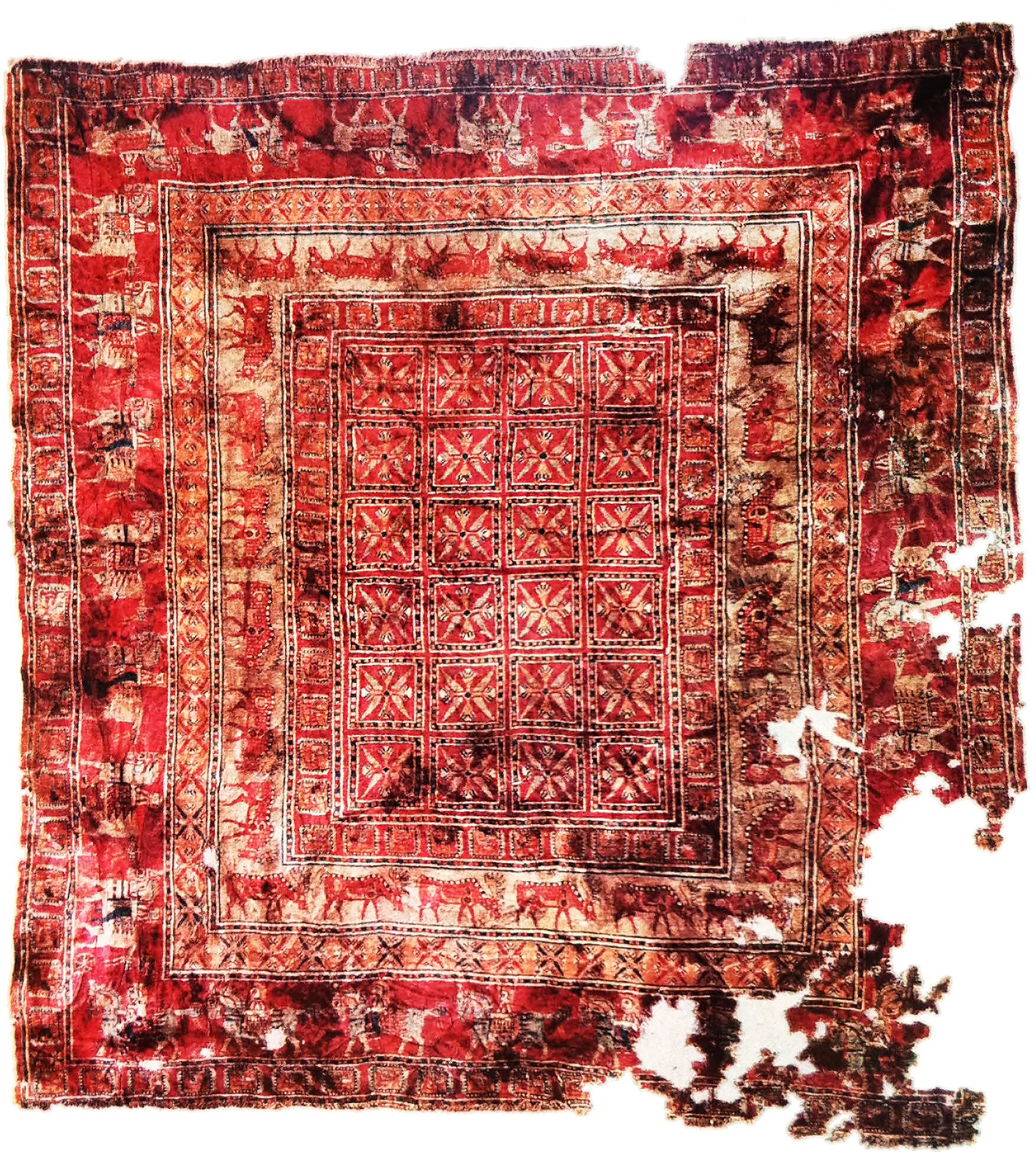

The horsemen are depicted in a stylized manner. Riders dismounting do so from the horse’s left, placing their right hand, holding the rein, on the horse’s back. The attire, including a headdress resembling a bashlyk tied at the chin, is characteristic of Medes and Persians. They wear short jackets with decorative edging and snug pants that end at the ankles. Their footwear appears to be soft, ankle-length shoes.
Source: The World’s Oldest Artistic Rugs and Textiles from Frozen Tombs in the Altai Highs. by Rudenko, Sergei Ivanovich – 1968
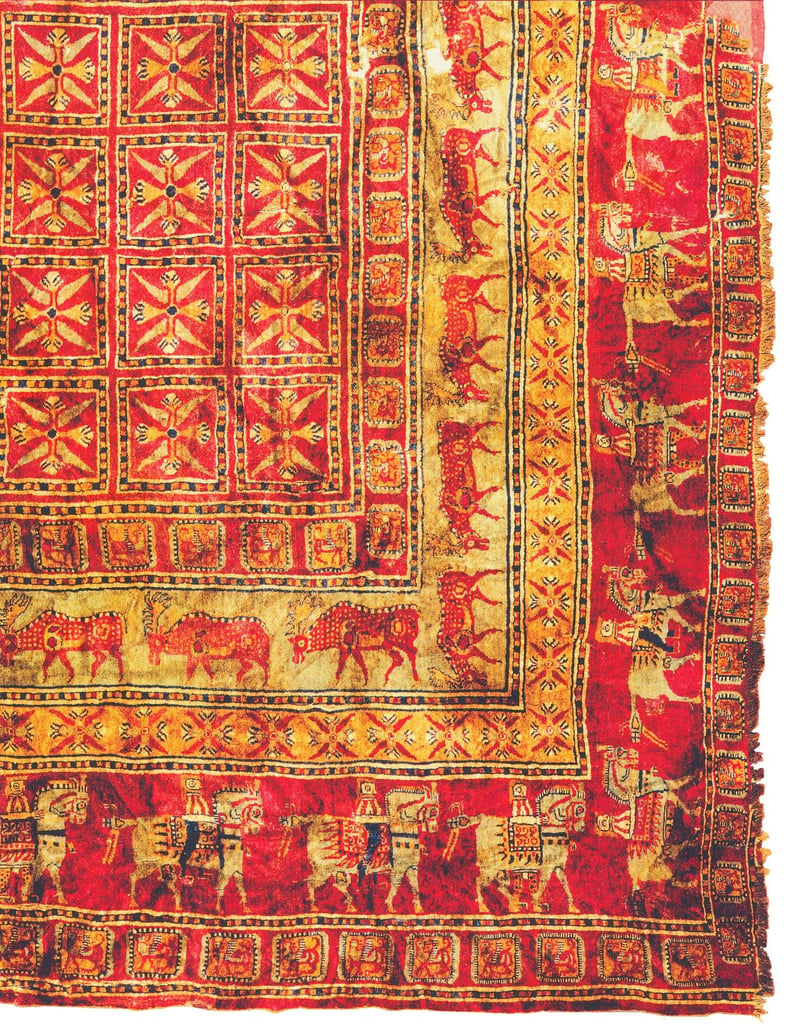
What truly sets the Pazyryk carpet apart, beyond its age, is its design. This carpet unfolds a mesmerizing mosaic of geometric shapes, abstract patterns, and vivid depictions of both deer and warriors. It’s crucial to recognize that these elements extend beyond mere decoration; instead, they serve as conduits for a captivating narrative.
The figures of warriors woven into the fabric may symbolize bravery and fortitude, while the graceful portrayal of deer pays homage to the unspoiled allure of nature. This emphasis on storytelling through design elevates the Pazyryk carpet beyond the realm of mere art, transforming it into a canvas of history waiting to be explored.
The Siberia’s unique climatic conditions has played a pivotal role in safeguarding this priceless treasure for millennia. Thanks to this fortuitous natural preservation, we can marvel at the carpet’s intricate details and vibrant colors with a sense of immediacy, as if it were unfurled only yesterday.
Post-Islamic Metamorphosis
Following the Islamic conquest of Persia in the 7th century AD, the artistic landscape of the region, including the renowned carpet weaving tradition, underwent significant transformations. The influence of Islam on this age-old craft was profound and multifaceted.
The principles of aniconism in Islam, which discouraged the depiction of living beings, especially humans and animals, shaped the design aesthetics of Iranian carpets. This led to a shift from earlier figurative designs to more abstract, geometric, and floral motifs.
Patterns that had once prominently featured animals or human figures started to evolve, giving way to the now-iconic Persian medallion patterns and arabesque designs. These intricate motifs soon became emblematic of Iranian carpets, distinguishing them in international markets.

Trade dynamics of the era also played a pivotal role in the carpet industry’s evolution. With the expansion of trade routes, Iranian carpets began to find their way to distant lands. Their designs, superior craftsmanship, and durability made them a sought-after luxury item in courts and households from Spain to China.
The era also witnessed a surge in royal patronage. Many Islamic rulers, captivated by the artistry of these carpets, became significant patrons, often commissioning exclusive designs.
This support from the elite not only ensured the industry’s survival but elevated carpet weaving from a mere craft to a revered form of high art.
One of the most distinguished features that emerged during this period was the integration of calligraphy into Iranian carpet designs. Artisans began weaving verses from the Quran, poetry, or sometimes their names into the carpets. This added an additional layer of meaning and depth to the already intricate designs, blending artistic expression with devotion.
Technological advancements during the Islamic Golden Age also left their mark on carpet weaving. New techniques were developed, and improved tools were introduced. This period of innovation contributed to the quality and variety of carpets produced, setting even higher standards for craftsmanship.
Finally, regional variations began to emerge more prominently. Renowned weaving centers like Tabriz, Kerman, and Isfahan started to develop and refine their unique styles, influenced by local traditions, resources, and artistic inclinations. Each region added its unique touch to the art of Iranian carpet weaving.
The Seljuq dynasty was a transformative era for Persian carpet making. With the spread of Islam across the region, new styles like the “Mihrab” design, representing the niche in a mosque that faces Mecca, came into vogue.
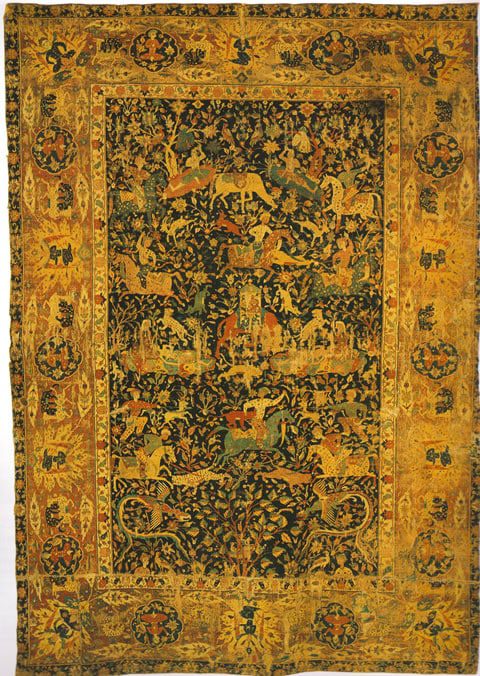
The golden age of Iranian carpet weaving is often attributed to the Safavid era in the 16th and 17th centuries. Shah Abbas, one of the notable rulers, took a keen interest in the arts, including carpet weaving. Master weavers like Kashan’s Maqsud were patronized, and the famous Ardabil Carpet was created during this period.
The Qajar dynasty saw the commercial expansion of the carpet industry. During this period, new dyeing techniques were developed, and exports began to Western countries. Today, Persian carpets are synonymous with luxury and elegance, and they remain a vibrant and vital part of Iran’s cultural heritage.
The resilience and versatility of this age-old craft are evident in how it has endured through multiple eras, each leaving its indelible mark on the patterns, colors, and textures that we celebrate today.
Features of Iranian Carpet
One of the most distinctive features of Persian carpets is the use of designs and patterns. These designs often incorporate geometric shapes, flowers, and other motifs that are symbolic of different aspects of Iranian culture. Many Persian carpets also feature a central medallion, which is a large, circular design that serves as the focal point of the carpet.
Traditional Iranian Dyeing Techniques
The art of traditional Iranian dyeing is one of the most distinctive features of the handwoven carpets of this land. This method prefers the use of natural materials to produce colors. Plants, minerals, and even insects are the main sources for obtaining natural colors. The colors derived from this method not only have a stunning beauty but also exhibit extraordinary durability and stability.
The traditional dyeing process requires high knowledge and skill, and each color has a unique preparation process. For instance, to produce red, the skin of pomegranates or red insects is used, while the blue color is obtained from the indigo plant. This variety of raw materials enables a wide range of colors, allowing the artist to create works that are both beautiful and lasting using nature.
Despite technological advancements and the shift towards modern dyeing methods, the traditional dyeing of Iranian carpets has still maintained its status.





The materials used in Iranian Carpets
The materials used in Iranian carpets are also of the highest quality. The base of the carpet is typically made from high-quality wool, which is soft, durable, and resistant to wear and tear. The wool is then dyed using natural pigments, which results in rich, vibrant colors that are resistant to fading.
Another important aspect of the Iranian carpet is the knotting technique used to create the pile. Persian carpets are typically made using the symmetrical knotting technique, which involves knotting the yarns around two warps, resulting in a higher knot density and a more detailed design.

In today’s world, Persian carpets are still highly sought-after and valued for their beauty and craftsmanship. They are often considered works of art, and can be found in museums, private collections, and high-end homes around the world. Many countries have their own traditional carpet but persian carpets are known as the best in the world.
Iranian Carpet Design
In addition to their beauty and craftsmanship, Persian carpets are also valued for their Iranian carpet design and cultural significance. Each design and pattern has its own unique meaning and history, reflecting the beliefs, customs, and traditions of the Iranian people. For example, the “Tree of Life” design, which features a central tree with branches and leaves radiating outwards, symbolizes the connection between heaven and earth and the continuity of life. Similarly, the “Haft sin” design, which features seven items starting with the letter “S” in Persian, symbolizes the creation of the world and the seven creations and holy immortals in Zoroastrianism.
Another important aspect of Iranian carpets is the regional variations. Different regions of Iran have their own distinct styles and techniques, reflecting the cultural, historical, and geographical influences of that area. For example, carpets from the city of Tabriz are known for their fine knotting and intricate designs, while carpets from the city of Kerman are known for their bold colors and geometric patterns.
It is also worth noting that Persian carpets are not only a traditional art form, but also an important economic industry. Many families in Iran rely on carpet weaving as their main source of income, and these carpets are often passed down through generations, preserving the tradition and heritage of the craft.
The Art of Carpet Weaving in Iran
The art of carpet weaving in Iran has its roots in the culture and customs of its people and their instinctive feelings. Weavers mix elegant patterns with a myriad of colors.
The Iranian carpet is similar to the Persian garden: full of flora, birds, and beasts.

The colors are usually made from wild flowers, and are rich in colors such as burgundy, navy blue, and accents of ivory.
The proto-fabric is often washed in tea to soften the texture, giving it a unique quality. Depending on where the rug is made, patterns and designs vary. And some rugs, such as Gabbeh, and Gelim have a variations in their textures and number of knots as well.

The exceptional craftsmanship in weaving these carpets and silken textile thus caught the attention of the likes of Xuanzang, Jean-Baptiste Tavernier, and Jean Chardin If there is one sector whose fate is intimately bound up with that of tourism, it is clearly that of the craft industry.
Indeed, whatever the type of tourism (resort holiday tourism or tour holidays), the foreign visitor never fails to take home the obligatory souvenir.
The majority of the reports that were undertaken make reference to, or describe in detail, the craft sector and its links to tourism. It must be said that the IRAN are distinguished by their quality craft industry, which draws on an authentic centuries-old tradition.

Accelerating and Decelerating factors for cultural tourism development in Iran in the field of handicraft is that the craft industry today clearly occupies an important place in the national economy with regard to employment, trade and, finally, the infusion of foreign currency.
However, there are still no statistics available that might give precise figures about the economic importance of tourism for the craft industry.
These craft products are valued and even sought out by visitors who discover them during a trip to the Iran, but they are unknown in Europe or another country.
Another thing is the survival of the craft industry, which is a key component of the living heritage and of culture in general, is vital in order to maintain this culture.
This craft industry has long resisted modern industrial products, with its clientele remaining attached to its traditional ways. Today, with the modernization of society, it is crucial for the craft industry to adapt .
The demand for craft products from neighboring countries and from tourists, which involves a change in the way these products are used, has enabled certain sectors to remain in place.

The third factor is The integration of the craft sector into the tourist policy occurs through a promotion formula initiated by the Ministry of Tourism. the reputation of this craft is better established within the Arab world and the clientele from neighboring countries seems to be the most promising.
Deterioration of the Craft Industry
A massive demand from tourism for craft items can have harmful effects. The craft industry, while benefiting from the demand from tourism, loses out on quality because this demand sometimes goes hand in hand with a dramatic degeneration of the finished product.
This decline in the craft industry is certainly not due to tourism, especially in the case of Iran, where it has been observed that the demand from tourism has had positive effects on the preservation of the craft heritage.
Handmade Silk Carpets
Silk plays a significant role in the production of Iranian carpets, particularly in the creation of high-quality and luxury pieces. Artisans use silk for its sheen and strength, making it a preferred material for both the warp and weft, as well as for the pile of the carpet in more luxurious examples. Silk allows for a higher knot count due to its thinness, which results in carpets with intricate designs and vibrant colors.





Social aspects of tourism in Iran could be a double-edge sword; therefore considerable measures need to be taken in order to preserve the culture.
Bazaar workers throughout the country, particularly the famous bazaars in Shiraz and Esfahan, are experiencing a decline in the number of youth willing to learn the traditional ways of making handicrafts.
Tourism can preserve these traditions due to demand from tourists. On the other hand, the government needs to be careful not to turn such handicrafts into mass produced, commercialized items as seen in many island nations that depend on tourism.
Why are Iranian Carpets Expensive?
Iranian carpets are considered to be expensive due to several factors.
One reason is the high-quality materials used to make them. The wool used in Persian carpets is of the highest quality and is carefully selected for its softness, durability, and resistance to wear and tear. Additionally, the natural dyes used to color the wool are also expensive and can take a significant amount of time and effort to produce.

Another factor is the intricate and time-consuming knotting process. Persian carpets are typically made using the symmetrical knotting technique, which involves knotting the yarns around two warps, resulting in a higher knot density and a more detailed design. This process can take months or even years to complete, depending on the size and complexity of the carpet.
The third factor is the amount of labor required to make a carpet, as Iranian carpets are handmade by skilled artisans. These artisans have to go through a long process of learning the craft, which takes many years and requires a lot of practice. Additionally, the labor-intensive process of making a carpet means that only a limited number can be produced each year, which can contribute to the higher cost.
Lastly, the cultural and historical significance of Persian carpets also plays a role in their high cost. These carpets are considered works of art, and are often passed down through generations, preserving the tradition and heritage of the craft. Many people view owning a Persian carpet as a symbol of prestige and wealth, which can contribute to the high cost.

What are Iranian Carpet Called?
Persian carpets are commonly referred to as “Iranian carpets” or “Persian rugs”. The term “Persian carpet” is often used to refer to any carpet that is made in Iran, regardless of the specific ethnic group or region of the country where it was produced. The term “Persian rug” is also commonly used to refer to the same thing. Both terms are widely accepted and used interchangeably to describe handmade carpets from Iran.
Types of Persian rugs include Bakhtiari, Bijar, Eshfahan, Farahan, Gabbeh, Heriz/Serapi, Kashan/Mohtasham, Kerman, Khorassan/Mashad, Persian Kilims, Malayer, Sarouk, Senneh, Sultanabad/Mahal and Tabriz.
Can I buy a Carpet in Iran?
Yes, it is possible to buy a carpet in Iran. Carpet weaving is an important industry in Iran and many shops and markets throughout the country sell a wide variety of carpets, including traditional Persian carpets. Some of the best places to buy carpets in Iran include major cities such as Tehran, Isfahan, and Tabriz, as well as smaller towns and villages that are known for their carpet-making traditions.
When shopping for a carpet in Iran, it’s important to keep in mind that prices can vary widely depending on the quality of the carpet, the materials used, and the level of craftsmanship. It’s also a good idea to have an idea of what you’re looking for in advance, as well as a good understanding of the different types of carpets available and the regional variations.
It’s also important to note that due to the US sanctions and regulations, buying a carpet from Iran, in some cases, might not be possible for some individuals and businesses based in the United States. It’s always best to check the current regulations and laws before making a purchase.
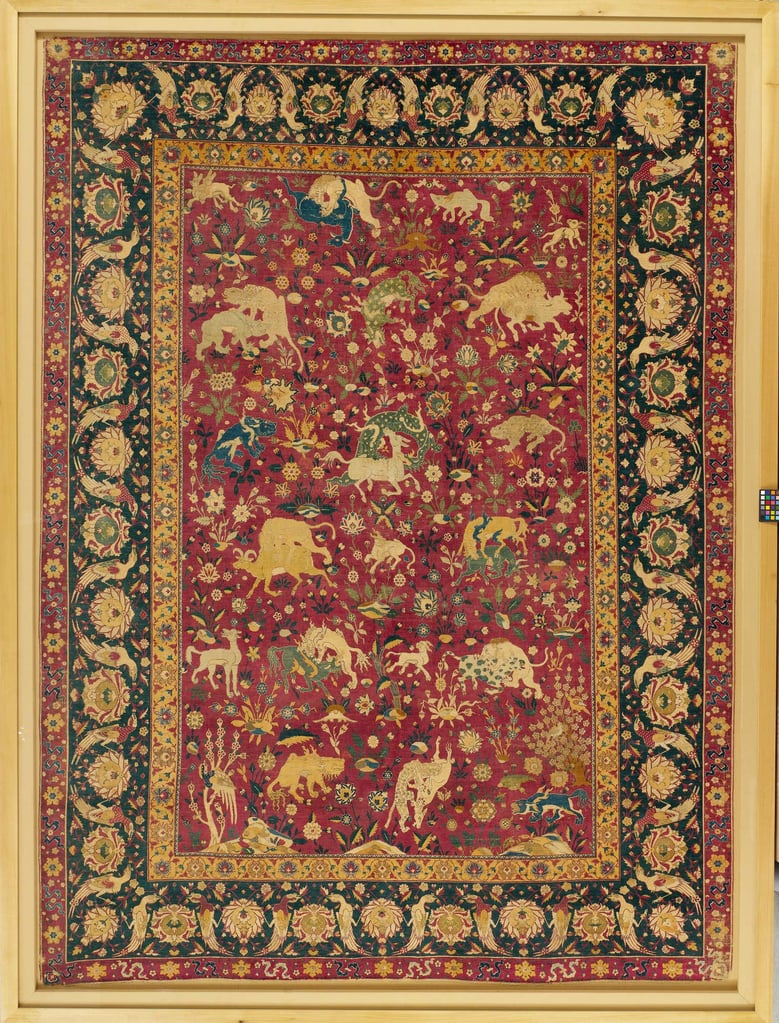
How Much is Iran Carpet?
The cost of an Iranian carpet can vary widely depending on a number of factors such as the size, design, materials, and craftsmanship. Hand-knotted Iranian carpets can range from a few hundred dollars for a small, simple rug to tens of thousands of dollars for a large, intricate rug.
For example, a small, simple rug with a low knot count and made from synthetic fibers can cost around $200 to $300. While a large, high-quality rug made from natural wool and silk with a high knot count and intricate design can cost anywhere between $5,000 to $50,000 or even more.
Additionally, the age and historical value of the rug can also affect the price. Antique Persian rugs are considered valuable not only because of their beauty, but also because of the historical significance and rarity. They can be priced quite high, sometimes reaching six figures.
It is also worth noting that the location of purchase can affect the price of an Iranian carpet. Carpets sold in Iran tend to be cheaper than those sold in other countries because of the import taxes and transportation costs.
How to Spot out Authentic Persian Rugs
There are several ways to tell if a Persian rug is real:
Look at the knot count: Persian rugs are made using a high knot count, which means that there are a lot of knots per square inch. A high knot count is one of the hallmarks of a quality Persian rug.
Inspect the materials: Persian rugs are typically made from high-quality wool, and the colors should be made from natural dyes. If the rug is made from synthetic fibers or the colors appear to be faded or washed out, it is likely not an authentic Persian rug.
Check for a signature or seal: Many authentic Persian rugs will have a signature or seal from the weaver or a workshop, which can provide evidence of its authenticity.
Look for signs of wear and tear: An authentic Persian rug will show signs of wear and tear, as they are handmade, and not machine-made.
Examine the design and pattern: Persian rugs are known for their intricate designs and patterns that often incorporate geometric shapes, flowers, and other motifs that are symbolic of different aspects of Iranian culture. If the design looks simple or repetitive it might be a machine-made rug.
Get an expert’s opinion: Finally, one of the best ways to tell if a Persian rug is real is to consult with an expert. There are many experts who specialize in the identification and authentication of Persian rugs, and they can provide valuable information about the rug’s age, materials, and authenticity.
Handmade vs. Machine-Made Rugs: Spotting the Differences
One of the most frequent questions carpet buyers have is, “How can you distinguish between a machine-made carpet and a hand-woven one?”
Experts can often identify whether a carpet is hand-woven or machine-made with just a quick look. However, given the wide variety of both hand-woven and machine-woven carpets available in the market today, it can be challenging for those less familiar with carpets to make this distinction.
Here are two ways to differentiate a hand-woven carpet from a machine-made one, clarifying the distinct differences through a closer examination of the details:
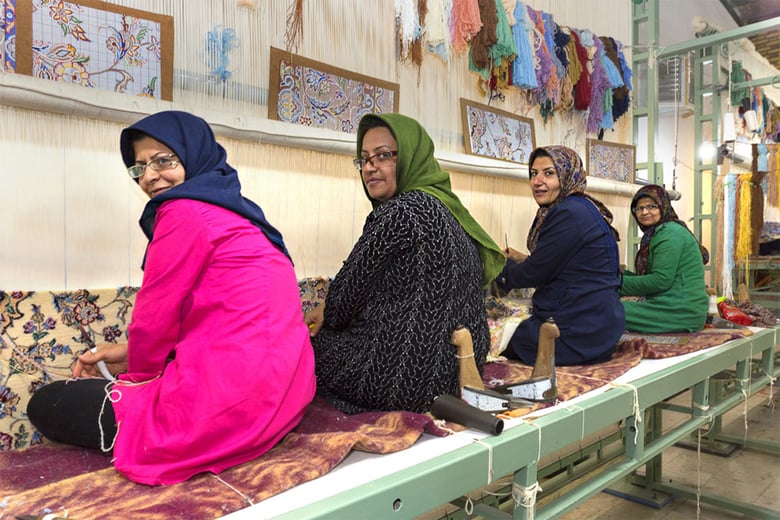

Look behind the machine and handwoven carpet
One of the most effective methods to distinguish between a machine-made rug and a hand-woven rug is by examining the rug’s back. In a hand-woven carpet, the knots appear slightly uneven and not uniformly perfect; some knots may be larger, while others may be smaller.
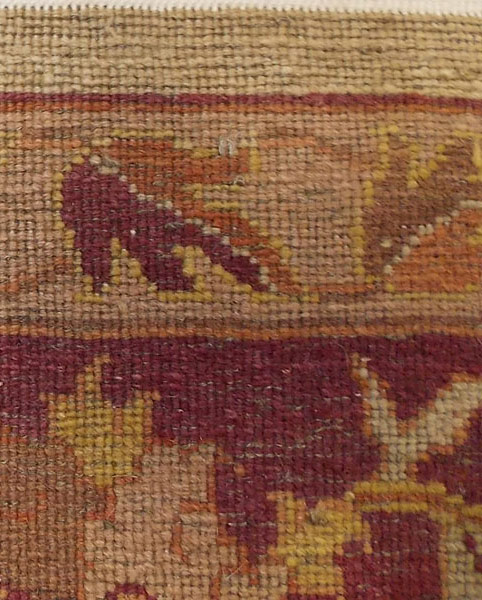

Examining the Roots of Carpets


Another method to identify whether a rug is hand-woven or machine-made involves inspecting the rug’s roots. As illustrated in the photo, the roots in a machine-made carpet are stitched onto it and are not an integral part of the carpet. However, the roots in a hand-woven carpet run along with the carpet and are an intrinsic component of it.
Can I Bring a Rug from Iran?
It is possible to bring a rug from Iran, but it is important to be aware of the regulations and laws that may apply to your purchase and importation of the rug.
Customs regulations vary by country, so it’s important to check with your local authorities to determine what restrictions may apply to your importation of a rug from Iran. Some countries may have restrictions on the importation of certain goods or may require special documentation, such as a certificate of authenticity or a permit, in order to bring a rug into the country.
In the case of the United States, due to the sanctions on Iran, there are some restrictions on the importation of goods from Iran, including carpets. The U.S Department of Treasury’s Office of Foreign Assets Control (OFAC) has specific regulations regarding the importation of Iranian-origin carpets and other Iranian-origin goods, and it’s important to check with them before attempting to import a rug from Iran.
It is also worth noting that in some cases, the cost of transportation, customs clearance, and taxes can be quite high, and it’s important to take these additional costs into consideration when determining the overall cost of the rug.
Conclusion
In conclusion, the Iranian Carpet stands not just as a piece of decor but as a testament to Iran’s deep-rooted history and cultural prowess. It represents a blend of artistic tradition and modern elegance, making it a must-have for those who value craftsmanship and heritage. As you consider adding this masterpiece to your collection, remember that you’re not just acquiring a rug; you’re embracing a piece of Iran’s soul and centuries of artisanal skill. Let the Iranian Carpet be more than an addition to your space; let it be a bridge to the rich tapestry of Iranian culture and history.
Read More




